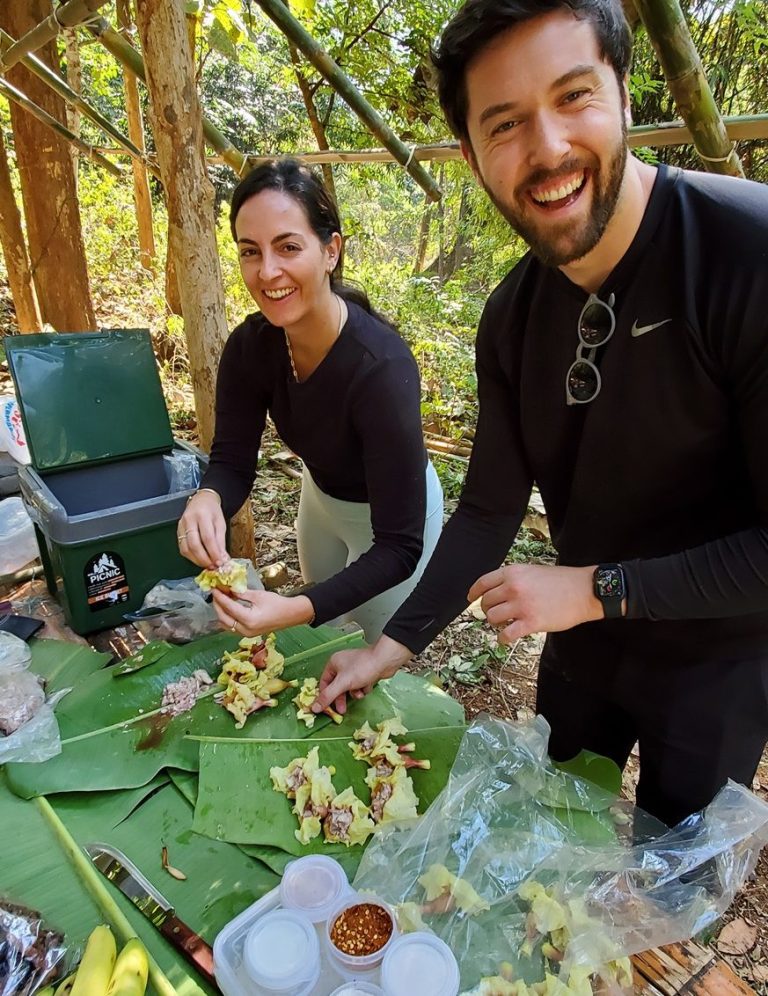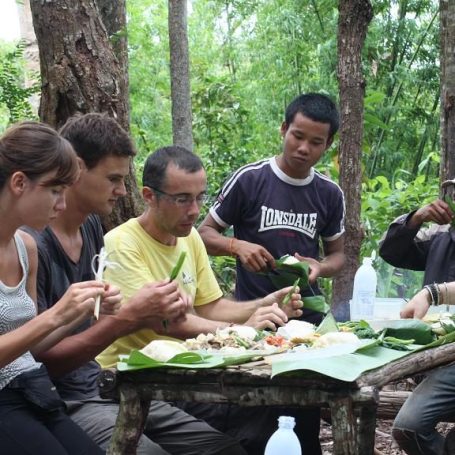Wild
Cooking-Class
Experience the Khmu culinary tradition as you learn to prepare a meal from what you can find in nature. Build a cooking space and craft utensils from bamboo then enjoy your meal in the forest.

Cooking Class Nature Expérience
During the path that will take you into the forest to start learning how the tribes of Laos cook in the forest, you will learn and pick the plants, which will compose the dishes that you will cook.
You will delve into the primary forest of Laos (10 minutes walk) to our carbet where you will learn how the tribes cook using bamboo, stone and other forest products.
You will also make your own eating chopsticks and glass (made of bamboo) which you can take home as a souvenir.
An exceptional and unforgettable moment!Join us on a journey into the forest to learn how Laotian tribes traditionally cook in the wild.
We’ll venture just 10 minutes into the primary forest of Laos to reach our shelter, where you will build your own kitchen space, table, and utensils out of bamboo and even make your own chopsticks and a bamboo cup to take home with you.
You will learn the traditional way of cooking using what is available to you, bamboo, stones, and other natural materials, then gather plants and ingredients from the forest that will be used to prepare your meal.
Adult: 85€ Children: 65€


Experience Overview:
- Start 8 a.m. return 3 p.m.
- Written recipe to follow
- Possibility of making a visit on the return trip as an option


Included:
- Transfer to and from your hotel
- All meal ingredients
- English/French/Lao speaking Guide
- Tax and entrance fees


Not included:
- Additional food and drink
- Gratuity
- Souvenirs
Recommended:
- Long Pants
- Mosquito repellent
- Hat
- Any other essential personal items.
Question Food in Laos
During excursions and over the years, we are always surprised by the variety of dishes and the difference in preparation between one valley and another or one district and another, Laotian cuisine is a journey in itself!
What food in Laos?
Celebrated British chef Gordon Ramsay has named Laos as his top choice among world food destinations.
This is what the 56-year-old chef said during an interview with Korean YouTuber Cho Seung-yeon.
The two discussed eating in the UK and the reputation of British foods, as well as the best places in the world to eat out.
And during the interview, Cho asks Ramsay, “Where would you say is the number one destination for foodies?” »
The famous chef replies that without a doubt, Laos was his first choice, for its diversity of dishes and tastes, as well as Vietnam and Spain.
What to eat in Laos?
While planning your trip, you will surely wonder what to eat in Laos, well, the cuisine of this country is very rich and tasty. Being an Asian country, if you like vegetables and soups, we are sure you will love it.
Influence of the cuisine of foreign countries on Laotian cuisine
Laotian dishes are a harmonious fusion of flavors and spices. Since Laos is bordered by Thailand to the west and Vietnam to the east, Lao culture, including its traditional cuisine, is directly and deeply influenced by the culinary traditions of these two neighboring countries.
For example, Laos and its neighbors often use rice or rice noodles in a wide variety of dishes due to their strong rice culture. Rice agriculture in these countries therefore has a significant impact on traditional cuisine. In fact, there are many similar dishes, such as green papaya salad and noodle soup, among others.
Additionally, after the French colonial period, elements of French cuisine were quietly introduced and blend harmoniously into many contemporary dishes. It is possible to find many French-style dishes and restaurants in Laos
What are the main dishes?
- Khao niao, or sticky rice, steamed and generally served in small bamboo or woven rattan baskets. It is kneaded in the hand into balls that are dipped into dishes like sauces with bread. It is possible to mix it with cooked egg yolks.
- The laap (Laap or laarb). “Lap” in Lao means “good luck”. This dish is the most emblematic of Laotian cuisine, with a beautiful meaning. It is considered a gift of choice during major holidays in Laos, such as New Year and weddings. It is a traditional Laotian salad composed of meat (beef, pork or duck) or chopped and lightly cooked fish, seasoned with lime and chili pepper. Accompanied by sticky rice, it is THE emblematic Laotian meal.
- Mok is first of all a method of steaming in a banana leaf, prepared more or less thinly, or even with the consistency of a pâté. It is a first cousin of the iconic Cambodian amok or Thai hok mok. The fish mok in coconut milk are particularly delicious. There are also meat mok, and ant egg mok mot (you read that right!), which, during the monsoon, are more on sale at the market than on the restaurant menu.
- Chinese-style sweet “sausage” pork sausages are served grilled or fried. Sai oua Luang Prabang is a pork sausage found in this city. It is often given as a gift by Laotians when visiting family.
- Gold lam is still one of the specialties of Luang Prabang. It's a stew made with baby eggplant, gooey mushrooms, pork rinds and wild chicken.
- Som mou are pieces of raw pork, marinated in vinegar and chili pepper inside banana leaves. They're delicious, but they still pose a risk, even for seasoned stomachs. Som pa is the same recipe with fish.
- Khao poun is a popular dish consisting of rice noodles, which can be served as soup, accompanied by a spicy coconut milk broth, bean sprouts and mint leaves.
- Buffalo meat dried in the sun and then grilled: it is quite strong, and it is better to have good teeth.
- Phó (pronounced "fire"), of Vietnamese origin, is one of the most popular dishes in Laos: soup of noodles and meat in strips or balls (often both), accompanied by small peppers, mint, bean sprouts, coriander and basil. (a little further down the origin of this dish will surprise you)
What to find in the markets?
If you go to a market to glimpse the infinite variety of products, which obviously impact food.
As for fruits and vegetables, there is an abundance of salads, cabbage, turnips, tomatoes, sweet turnips, pineapples, coconuts, papayas, several varieties of banana (plantain, pome banana, etc.), banana flowers, banana beans, soy, potatoes, taros, durians, etc.
They eat bats, squirrels, civets, snakes, monitor lizards, but also bamboo and rice field rats (not those from cities). You can find them on some market stalls. Dog meat is appreciated and eaten in specialized restaurants. Cicadas and grasshoppers, on the other hand, are fried.
If you go to a market to glimpse the infinite variety of products, which obviously impact food.
As for fruits and vegetables, there is an abundance of salads, cabbage, turnips, tomatoes, sweet turnips, pineapples, coconuts, papayas, several varieties of banana (plantain, pome banana, etc.), banana flowers, banana beans, soy, potatoes, taros, durians, etc.
If seafood products are absent for obvious geographical reasons, the Mekong is however full of... farmed fish, dams and pollution having greatly reduced the number of wild fish. They are nevertheless tasty, particularly tilapia, eaten grilled or in mok.
What is the origin of “phó” (fire)?
- Phó (pronounced “fire”), is of Vietnamese origin, it is one of the most popular dishes in Asia, Vietnam, Thailand and particularly Laos
Originally he is French! and yes ! it is the French presence which gave birth to this dish. The French settlers, in search of French cuisine, asked the Vietnamese and Laotian cook, explaining the ingredients and cooking, to cook them a “pot-au-feu” which gave birth to: fire “phó” now you find them all over Asia!
Certainly, nowadays the recipe has changed somewhat over time, here are the ingredients: soup of noodles and meat in strips or balls (often both), accompanied by small peppers, mint, bean sprouts, coriander and basil, which everyone can prepare as they wish.
Support for the Khmu Villages
Every Excursion = A Contribution.
On a monthly basis, we engage with the chief of the village to assess the needs of the village, with a particular focus on supporting the children of Laos by supplying clothing and essential school items such as notebooks and pens along with other educational material. We strive to make a meaningful and sustainable impact in enhancing the learning environment for under privileged families.
Nous avons besoin de votre consentement pour charger les traductions
Nous utilisons un service tiers pour traduire le contenu du site web qui peut collecter des données sur votre activité. Veuillez consulter les détails dans la politique de confidentialité et accepter le service pour voir les traductions.

